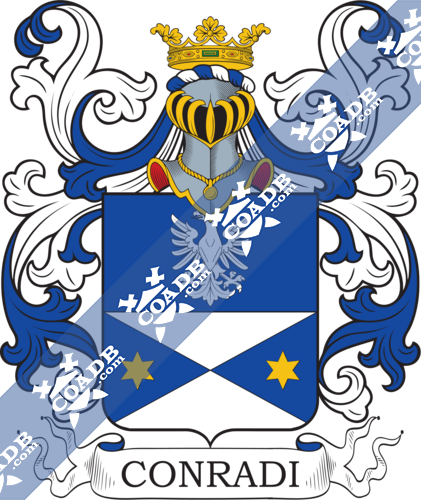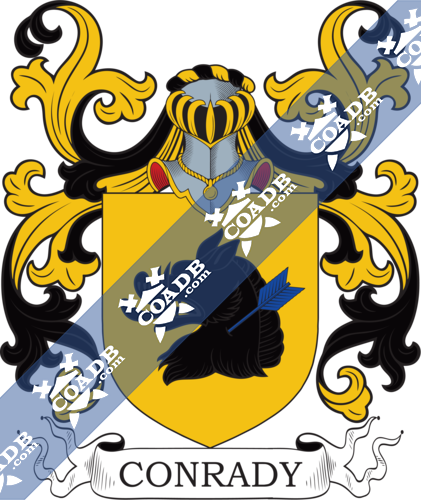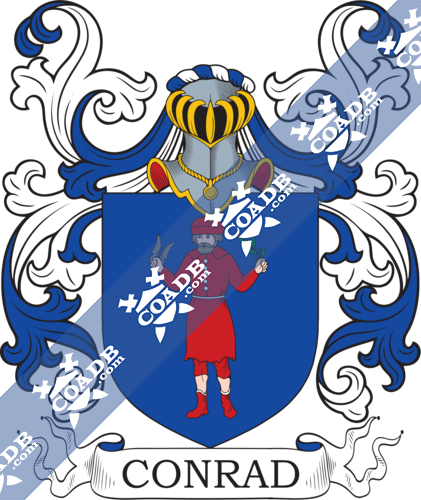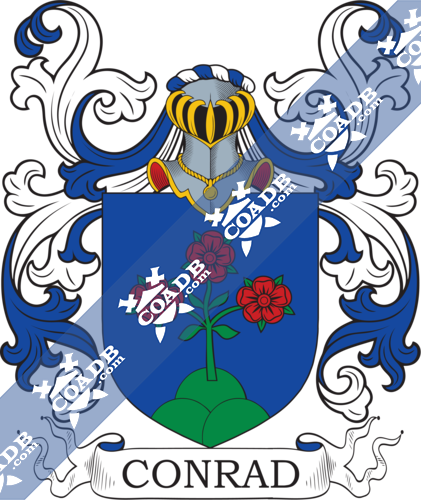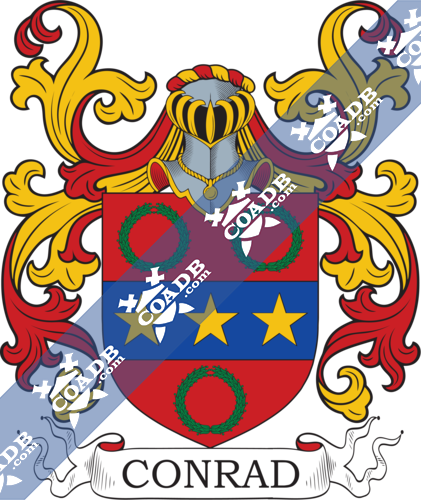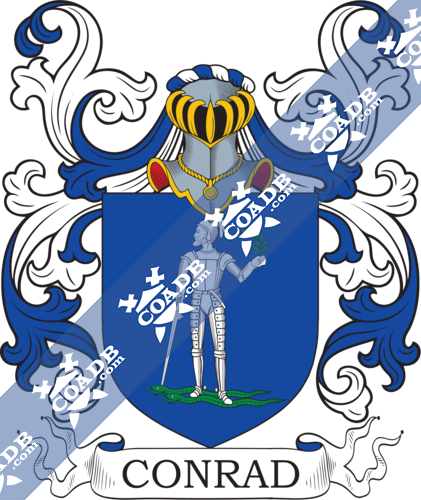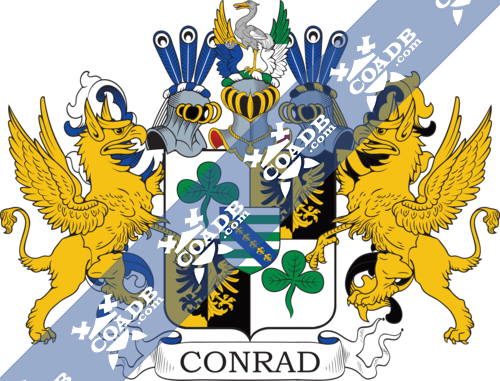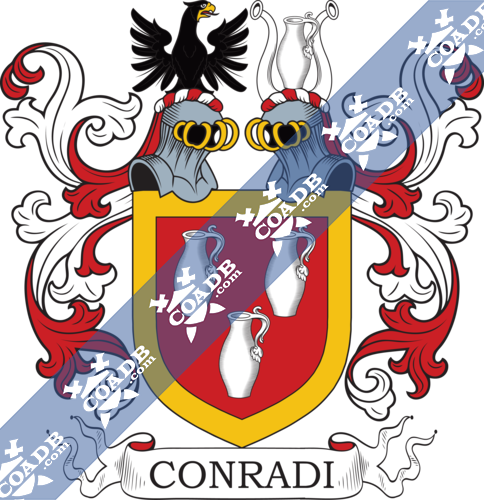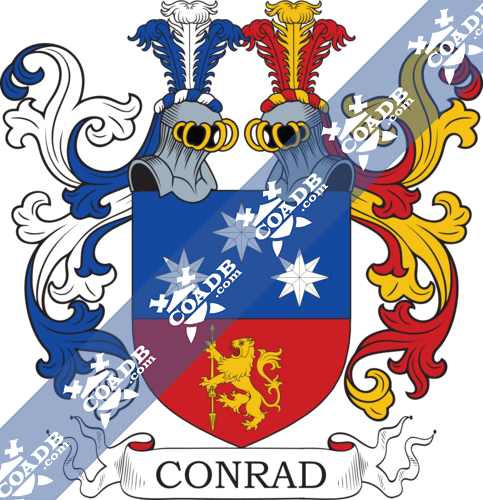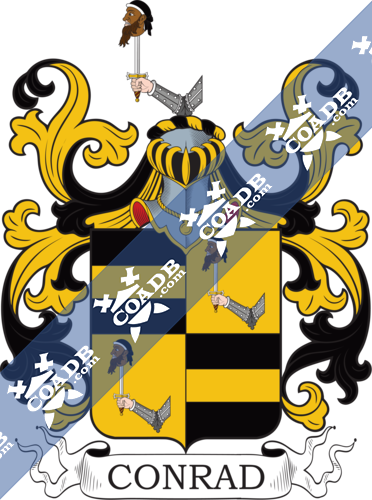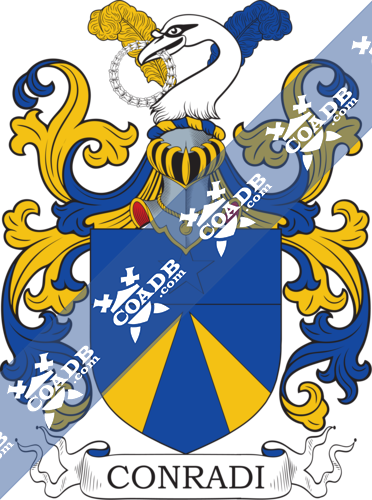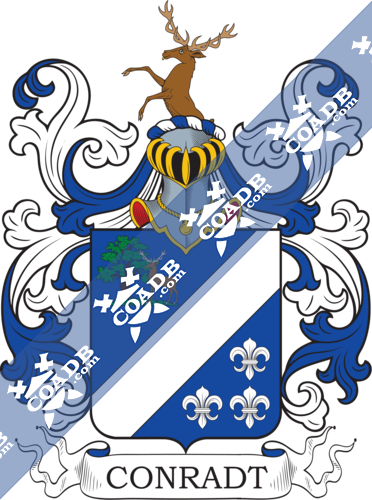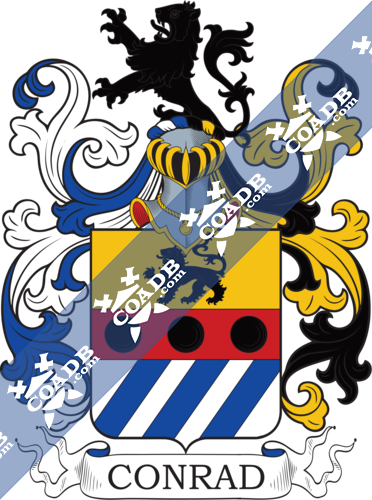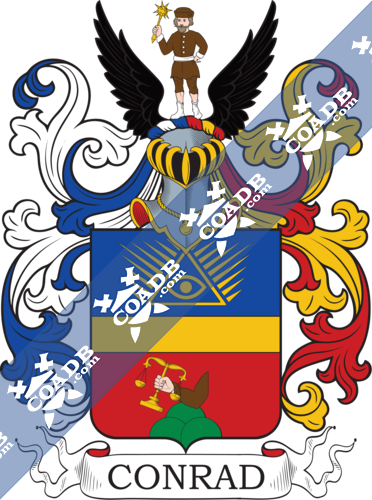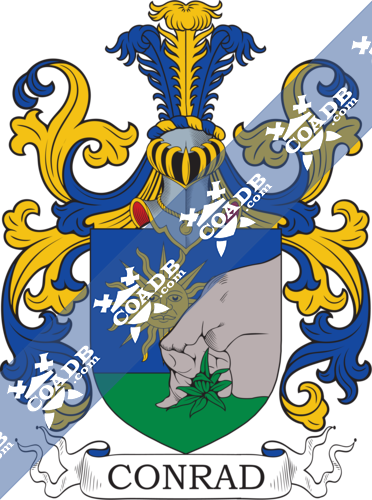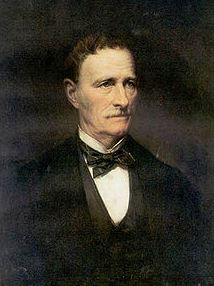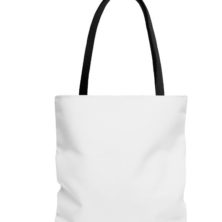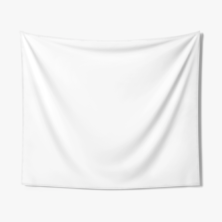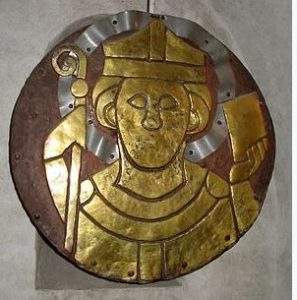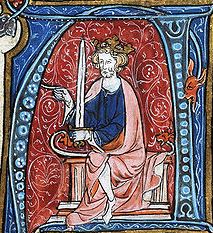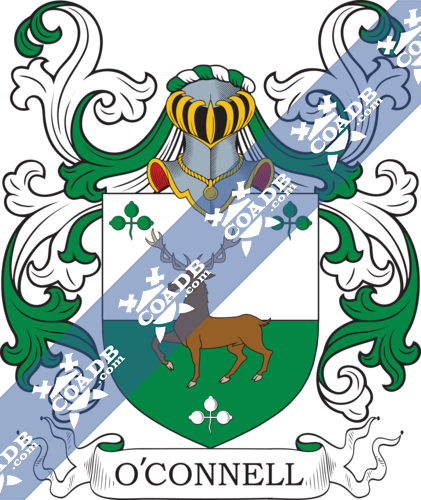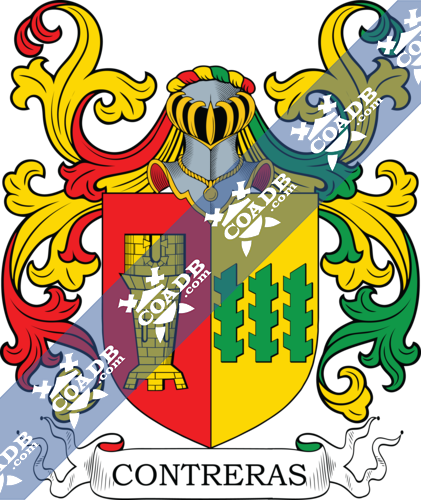Conrad Family Crest, Coat of Arms and Name History
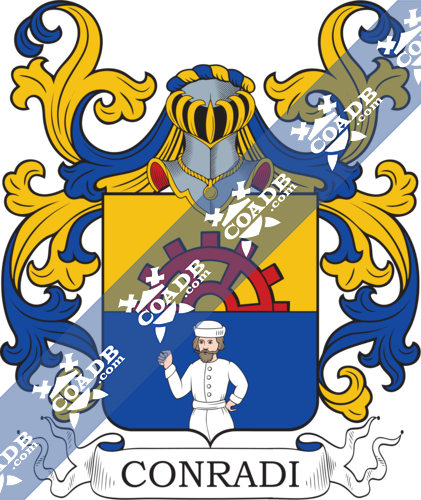
Conrad Coat of Arms Gallery
Don’t know which Coat of Arms is yours?
We can do a genealogical research. Find out the exact history of your family!
Learn MoreConrad or Konrad is a popular surname that derives from the Germanic personal (first) name Konrad, which consists of the words kuoni, meaning daring and/or experienced, and rad or rat, meaning counsel. Hence this common last name literally translates to bold or able counse. There was also another personal German name whose first element was the word chunni or kuni, meaning race and people. The two names eventually converged. Other say it derives from the word conja, meaning bold. The name is an old one, dating back to before the 600’s AD. The masculine given name Konrad became very popular in Germany, Scandinavia, and central Europe during medieval times and the Middles Ages. It became a hereditary name inside of several noble families. It was also adopted by other cultures such as Slovenians and Ashkenazic Jews. One source states the name was originally from the Kingdom of Bohemia (modern day Czechoslovakia), an important state in the Holy Roman Empire. It’s use as a personal name became popular in the English-speaking world in the 1800s.
One of the first notable bearers was Saint Conrad of Constance, a German Bishop and Saint who was born around 900 AD. An early bearer of this last name was Conrad Conradi who was documented to have lived in the German town of Elsabe in 1297 AD. The name was also born by many noble and royal individuals in Europe during the Middle Ages, including: 1) Conrad I of Germany (reign 911-923 AD), an East Francian king who was the first ruler not from the Carolingian dynasty, 2) Conrad II (reign 1027-1039 AD) who was the Holy Roman Emperor, King of Burgundy, King of Germany, and King of Italy, and 3) Conrad the Red (reign 944-953) who was the Duke of Lorraine. There was also a King of Wessex or Mercia in Britain named Coenred (lived from 675-709 AD).
The name has a multitude of spelling variations and forms, including, but not limited to: Konrad, Kunrad, Kondrat, Conradi, Cunrads, Kunrath, Conrath, Coonrod, Konred, and Conrade. The only Conrad family motto I was able to find is “Charitas”, which is Latin for charity.
Some notable of famous bearers of this last name include: 1) Charles “Pete” Conrad Jr. (1930-1999) who was an American aviator, test pilot, naval officer, and NASA astronaut born in Philadelphia, Pennsylvania, 2) Charles Magill Conrad (1804-1878) who was a Senator for Louisiana from 1842-1843, a member of the House of Representatives from 1849-1850, and the 22nd US Secretary of War from 1850-1853, 3) Victor Conrad (1876-1962) who was an American physicist, seismologist, and meteorologist who was born in Vienna, Austria, 4) Gaylord Kent Conrad who was a US Senator from North Dakota from 1992-2013, and 5) James Conrad (born 1977) who was a professional American soccer player who had a 13 season career in the MLS and was on the team that played in the 2006 World Cup.
Some early American immigrants who came during colonial times included Matthew (and wife Anna) Conrad (New York 1709) and Johanna Heinrich Conrad (New York 1709). Several members of this family arrived in Nova Scotia, Canada in 1757, including: Caspar, Catharina, George, Jacob, and Lorentz Conrad.
Bartlome Churet was born in Attiswil, Berne, Switzerland in 1645. He married Barbara Ryff and had a son with her named Jacob Curet. Jacon was born in Oberpbipp, Bern in 1673. He married Leysi and had sons with her named Ulrich Conrad and Jacob Conrad Sr. The latter was born in Berne, Switzerland in around 1705. He came to colonial America aboard the Patience in 1750, arriving in Philadelphia, Pennsylvania. He married Frena Svena Lauk (while still in Europe) and had issue with her as follows: Barbara (Hedrick), Jacob, Elizabeth (Fisher), and Mary. They lived in Virginia. His son Jacob was born in Arriswele, Switzerland in 1744. He married Hannah Bogard and later Barbara Propst, having the following children: Sabina, Frances (Kyle), Barbara (Harper), Jacob, Benjamin, Mary (Coil), Peter, Phoeba (Kile), Daniel, Annie, John, and Ulrich. His son Peter Conrad I was born in Pendleton County, West Virginia in 1777. He married Ann Currence, and had the following children with her: Elizabeth (Saulsbury), Sarah (Wamsley), Phoeba (Cowger), Ailcey (Wamsley), Diana (Cowger), John B., Maria (Doddrill), Mary (Curtis), Peter B. Jr., Jacob, Rachel, Barbara, Nancy Ann, and Syrena (Clark). His Son Peter B. Conrad Jr. was born in West Virginia in 1817. He married Ailcey Arbogast and had two daughters with her: Priscilla Dean and Eda Stalnaker. He died in 1897.
Here is another family pedigree of father and son:
Hans Conrad (born around 1580)
Knabe Conrad (born in Duchroth, Germany in 1600)
Balthasar Conrad (born in 1625)
Johann Adam Conrad (born in Weinsheim, Rheinland-Pfalz in 1651)
Johann Peter Conradt (born 1687 in Germany, went to Pennsylvania)
Jacob Johann Conrad Sr. (born in 1734 in Niederhauser, Germany, came to America with father)
Jacob Johann Conrad Jr. (born in Pennsylvania in 1765)
The aforementioned Jacob married Catherine Stainbrook and had three sons with her: Johann Henry, Jacob, and John Nicholas. Each of these sons in turn had sons. One of the sons was Johann Henry Conrad (born in Pennsylvania in 1793). His son was Jeremiah Franklin Conrad (born in North Carolina in 1828). He married Mary Marcum and had the following issue with her prior to his 1905 death in Indiana: Sarah Jane, James, William Jefferson, Lewis David, Hiram, and Elizabeth.
According to dsconrad.com, “There are four genealogical lines of Conrads/Conrods that I have found so far. There are two Nova Scotian lines, the line of Jacob Conrad and the line of Matthias Conrad. (My line is Matthias) American Conrads/Conrods include Canadian Conrads who emigrated to the U.S. There is a purely American line of Conrads. The Conrads of Uniontown, Pennsylvania, descend from Maximilian Conrad, born in Alsace-Loraine, Germany, who after his marriage in Havre, France, came in 1847 to the United States. He settled in Pittsburgh, Pennsylvania, where he resided until his death”.
Blazons & Genealogy Notes
1) Styrie – (Chevaliers, 1 déc. 1854; barons, 20 fév. 1874) – Écartelé aux 1 et 4 de sable à la fasce d’or aux 2 et 3 d’or à un bras armé au naturel tenant une épée en pal supportant une tête de Turc coupée au naturel coiffée d’un turban de sable enveloppé d’argent Casque couronné Cimier le bras du 2 posé sur le coude Lambrequin d’or et de sable. English: Quarterly 1st and 4th sable a fess or 2nd and 3rd or with an arm armoured proper holding a sword palewise supporting a head of a Turk per fess proper wearing on the head a turban sable wrapped argent Crowned with a helmet Crest: the arm of the 2nd placed on the elbow Mantling: or and sable.
2) Silésie – Coupé au 1 d’azur à trois étoiles (8) mal-ordonnées d’argent au 2 de gueules au lion d’or lampassé de gueules tenant de ses pattes une lance de tournoi d’or en pal Deux casques couronnés Cimiers 1° trois plumes d’autruche une d’argent entre deux d’azur Lambrequin d’argent et d’azur 2° trois plumes d’autruche une d’or entre deux de gueules Lambrequin d’or et de gueules. English: Per fess 1st azure three etoile of 8 points disordered [1 2] argent 2nd gules a lion or langued gules holding in its paws a tournament lance or palewise Crowned with two helmets Crests: 1st three ostrich feathers one argent between two azure Mantling: argent and azure 2nd three ostrich feathers one or between two gules Mantling: or and gules.
3) Transylvanie – (Chevaliers, 30 juillet 1868) – D’azur à un homme habillé de gueules tenant de sa main dextre une force et de sa senestre un rameau d’olivier de sinople. English: Azure with a man dressed gules holding in his dexter hand a pair of shears and in his sinister an olive branch vert.
4) Transylvanie – (Au., 1 avril 1610) – Coupé d’or au lion léopardé de sable sur argent à trois barres d’azur à la fasce de gueules ch de trois boules de sable brochant sur le coupé Cimier un lion issant de sable Lambrequin à dextre d’argent et d’azur à senestre d’or et de sable. English: Per fess or a lion passant sable over argent three bendlets sinister azure a fess gules charged with three balls sable covering over the partition Crest: a lion issuant from sable Mantling: to the dexter argent and azure to the sinister or and sable.
5) Coire – D’azur à une branche de sinople feuillée du même fleurie de trois roses mal-ordonnées de gueules posée sur un tertre de trois coupeaux du second (Nob du St-Empire 28 juin 1611) Écartelé aux 1 et 4 de sable au lion d’or aux 2 et 3 les armes de 1608 Casque couronné Cimier un lion assis d’or posé de front entre deux proboscides coupées à dextre d’argent sur gueules à senestre d’or sur sable qu’il empoigne de ses griffes Lambrequin à dextre d’or et de sable à senestre d’argent et de gueules. English: Azure with a branch vert leaved of the same flowered of three roses disordered [1 2] gules placed on a hillock of three peaks of the second Alternatively quarterly 1st and 4th sable a lion or 2nd and 3rd the coat of arms of 1608 (Those above?) Crowned with a helmet Crest: a lion sejant or placed facing forwards between two proboscides per fess to the dexter argent over gules to the sinister or over sable which it is grabbing in its claws Mantling: to the dexter or and sable to the sinister argent and gules.
6) Autriche – (Conc. d’arm., 20 sept. 1608) – De gueules à la fasce d’azur ch de trois étoiles d’or et acc de trois couronnes de feuillage de sinople. English: Gules a fess azure charged with three etoiles or and accompanied by three crowns of leaves vert.
7) Prusse – D’azur à un chevalier armé de toutes pièces d’argent foulant aux pieds deux serpents tenant de sa main dextre une épée dont il perce l’un des serpents et de sa senestre un rameau d’olivier de sinople. English: Azure with a knight fully armoured argent walking with his feet on two snakes holding in his dexter hand a sword which pierces one of the snakes and in his sinister an olive branch vert.
8) Edle von Heldendorff – Transylvanie – (Nob. du St.-Empire, 27 mars 1696) – Coupé au 1 d’azur à un oeil triangulaire d’or rayonnant du même au 2 de gueules à une colline de trois coupeaux de sinople soutenant un senestrochère paré d’un vêtement brunâtre la main de carnation tenant une balance d’or A la fasce d’or brochant sur le coupé Casque couronné Cimier un homme issant vêtu d’un habit brunâtre bordé d’argent et de haut-de-chausses d’argent ceint de gueules bordé d’argent coiffé d’un bonnet de fourrure tenant de sa main dextre une masse d’armes levée d’or la senestre appuyée sur sa hanche le tout entre un vol de sable Lambrequin à dextre d’argent et d’azur à senestre d’or et de gueules. English: Per fess 1st azure with a triangular eye or rayonny of the same 2nd gules with a hill of three peaks vert supporting a left arm clothed [dressed] in brown clothing the hand carnation holding a set of scales or Overall the fess or covering over the partition Crowned with a helmet Crest: a man issuant dressed in brown habit bordered argent and with high boots argent belted gules bordered argent wearing on the head a hat of fur holding in his dexter hand a mace upright or the sinister resting on his hip all between a pair of wings sable Mantling: to the dexter argent and azure to the sinister or and gules.
9) Conrad de Conradsheim – Transylvanie – (An., 10 nov 1844; barons, 30 août 1851) – D’azur à un rocher au naturel à senestre soutenu d’une terrasse de sinople adextrée d’un soleil levant d’or Cimier trois plumes d’autruche une d’or entre deux d’azur Lambrequin d’or et d’azur. English: Azure with a rock proper to the sinister standing on a mount vert having to the dexter a sun rising or Crest: three ostrich feathers one or between two azure Mantling: or and azure.
10) Conrad de Sonnenstein – Transylvanie – (An., 10 avril 1807) – Écartelé aux 1 et 4 d’argent à un trèfle de sinople aux 2 et 3 parti d’or et de sable à l’aigle éployée de l’un en l’autre Sur le tout burelé d’argent et de sinople à la bande d’azur brochant sur le burelé et ch de sept fleurs-de-lis d’or posées dans le sens de la bande Trois casques couronnés Cimiers 1° trois plumes de paon au naturel Lambrequin d’argent et d’azur 2° une grue avec sa vigilance au naturel entre un vol coupé à dextre d’or sur azur à senestre de sinople sur argent Lambrequin à dextre d’or et d’azur à senestre d’or et de sinople 3° trois plumes de paon au naturel Lambrequin d’or et de sable Supports deux griffons d’or. English: Quarterly 1st and 4th argent with a trefoil vert 2nd and 3rd per pale or and sable with an eagle displayed counterchanged overall barry argent and vert a bend azure covering over the barry and charged with seven fleur de lys or placed in the direction of the bend Crowned with three helmets Crests: 1st three peacock feathers proper Mantling: argent and azure 2nd a crane with its vigilance proper between a pair of wings per fess to the dexter or over azure to the sinister vert over argent Mantling: to the dexter or and azure to the sinister or and vert 3rd three peacock feathers proper Mantling: or and sable Supporters two griffin or.
11) Conrad d’Eybesfeld – Styrie – (An., 12 avril 1854; barons, 15 mars 1870) – Parti au 1 d’azur à une demi-roue de mouv du parti au 2 de gueules à trois épées rangées en fasce celle du milieu la pointe en bas Cimier un bras armé tenant une épée. English: Per pale 1st azure with a demi wheel coming from the partition [pale] 2nd gules three swords arranged fesswise that of the middle the point downwards Crest: an arm armoured holding a sword.
12) Hollande – Parti au 1 d’argent à une branche de chêne de sinople terrassée du même poussant en bas à dextre et à senestre une feuille du même et portant trois glands l’un au sommet le deuxième en haut à senestre le troisième au milieu à dextre au 2 d’argent à une aigle de Prusse tenant un sceptre et une épée Casque couronné Cimier un bras armé tenant une épée en barre le tout au naturel. English: Per pale 1st argent with a branch of oak vert on a mount of the same pushing downwards to the dexter and to the sinister a leaf of the same and carrying three acorns the one at the top upwards the second to the sinister the third to the dexter 2nd argent with an eagle of Prussia holding a sceptre and a sword Crowned with a helmet Crest: an arm armoured holding a sword bendwise sinister all proper.
13) Prusse – (An., 10 mars 1749) – De gueules à trois cruches à anse d’argent l’écu bordé d’or Deux casques couronnés Cimiers 1° une aigle de Prusse issante la tête contournée 2° une cruche d’argent entre deux proboscides du même Lambrequin d’argent et de gueules. English: Gules three jugs with handles argent the shield fimbriated or Crowned with two helmets Crests: 1st an eagle of Prussia issuant the head reversed 2nd a jug argent between two proboscides of the same Mantling: argent and gules.
14) Prusse – (Barons, 5 juin 1798. M. ét. le 4 avril 1799) – D’azur à deux pointes d’or mouv de la base de l’écu posées en chevron au chef d’azur ch d’une étoile (5) du champ Cimier une tête et col de cygne d’argent tenant en son bec une couronne de laurier du même entre deux plumes d’autruche d’or et d’azur. English: Azure two points or coming from the base of the shield placed in chevron a chief azure charged with an etoile of 5 points of the field Crest: a head and shoulder of a swan argent holding in its beak a crown of laurel of the same between two ostrich feathers or and azure.
15) Finlande – (An., 20 avril 1769) – Coupé au 1 d’or à une demi-roue de moulin de gueules mouv du coupé au 2 d’azur à un homme issant mouv de la pointe habillé d’argent coiffé d’un bonnet albanais du même Lambrequin d’or et d’azur. English: Per fess 1st or with a demi mill wheel gules coming from per fess 2nd azure with a man issuant coming from the base dressed argent wearing on the head a Albanian [woollen?] hat of the same Mantling: or and azure.
16) Nuremberg – Coupé au 1 d’azur à l’aigle d’argent couronnée du même au 2 écartelé en sautoir d’argent et d’azur l’azur chargé d’une étoile (6) d’or Couronne de duc Devise CHARITAS. English: Per fess 1st azure with an eagle argent crowned of the same 2nd quarterly per saltire argent and azure the azure charged with a etoile of 6 points or crown with a small owl Motto: CHARITAS.
17) Mayorque – Originaire de Gênes – Parti au 1 d’argent à un sanglier rampant de sable tenant de ses pattes de devant une flèche d’azur au 2 d’argent à un mur de gueules supp un homme armé de toutes pièces tenant de sa main dextre une épée et de sa senestre un bouclier Casque couronné Cimier l’homme armé. English: Per pale 1st argent with a wild boar rampant sable holding in its paws the front an arrow azure 2nd argent with a wall gules Supporters a man fully armoured holding in his dexter hand a sword and in his sinister a small circular shield Crowned with a helmet Crest: the man armed.
18) Conradt-Eberlin – Danemark – (An., 30 août 1783) – D’azur à la barre d’argent acc en chef d’un cerf arrêté au côté d’un arbre sur une terrasse le tout au naturel et en pointe de trois fleurs-de-lis mal-ordonnées du second Casque couronné Cimier un cerf issant au naturel. English: Azure with a bend sinister argent accompanied by in chief a stag statant at the side of a tree on a mount all proper and in base by three fleur de lys disordered [1 2] of the second Crowned with a helmet Crest: a stag issuant proper.
19) Prusse – (Nob. du St.-Empire, 9 juin 1779) – D’or à une hure et col de sanglier de sable le col percé d’une flèche d’azur en barre la pointe en bas. English: Or with a head and shoulders of a wild boar sable the shoulder pierced by an arrow azure bendwise sinister the base downwards.

